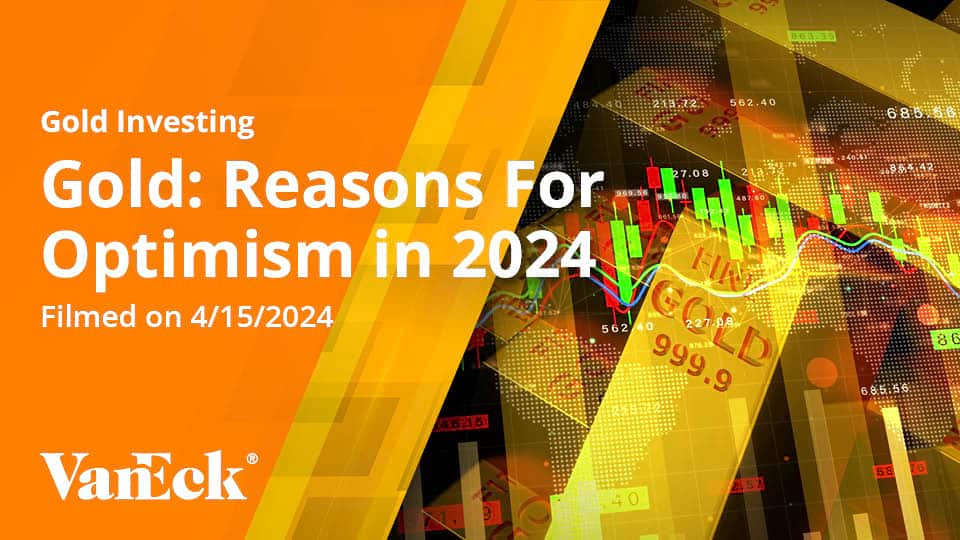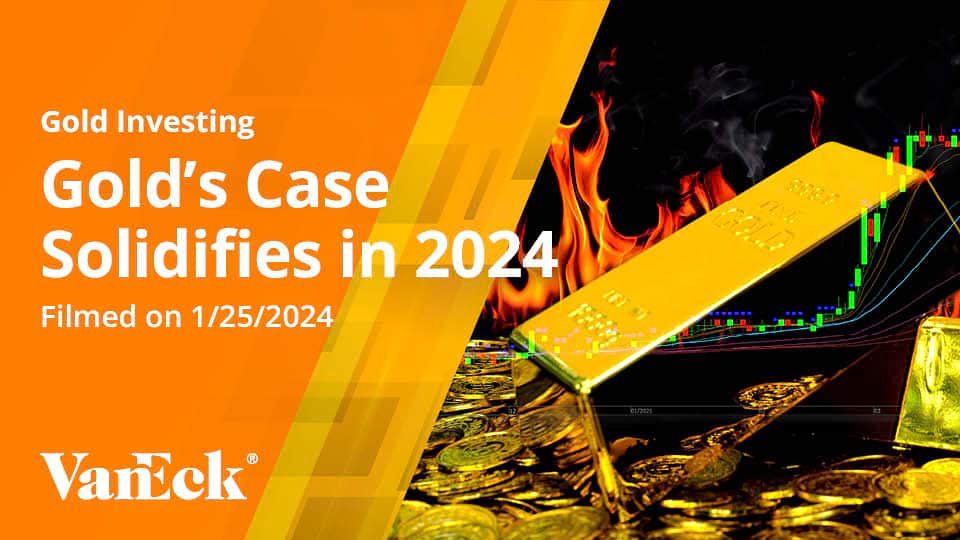Gold Miners are Digging In (Despite Your Disinterest)
13 March 2024
Read Time 5 MIN
Monthly gold market and economic insights from Imaru Casanova, Portfolio Manager, featuring her unique views on mining and gold’s portfolio benefits.
Little love for gold (and even less for the miners)
Gold was little-changed in February, closing below $2,000 per ounce on February 13 and 14 before moving back and holding above this level for the remainder of the month. Gold eventually settled at $2,044 per ounce on February 29, up 0.23% for the month. U.S. core and headline Consumer Price Index (CPI) readings for January were above consensus expectations, pushing out the likelihood of a U.S. Federal Reserve (Fed) rate cut to later in the year and putting pressure on gold by mid-month. Gold later found support to establish an average closing price of $2,029 per ounce so far this year – not too bad, considering that, over the same time period, the U.S. dollar (as measured by the DXY Index1) is up 2.8% and gold bullion investment demand (as gauged by holdings in gold-backed ETFs) is down 3.7%.
While gold bullion was seemingly unloved this past month, gold stocks basically had their heart broken. The NYSE Arca Gold Miners Index (GDMNTR)2 and the MVIS Global Juniors Gold Miners Index (MVGDXJTR)3 were down 6.10% and 6.84%, respectively, in February, further widening the already significant valuation gap against the metal. The first days of March have brought some relief to gold equity investors, though, with gold mining stocks strongly outperforming gold bullion as gold reaches new all time-highs. This could be the beginning of a reversion-to-the-mean trend that sees gold mining equities once again display their leverage to the gold price and outperform bullion when gold prices are rising. For reference, GDMNTR would have to more than double from current levels to reach its peak of August 2011—so there still appears to be a fair amount of potential runway just based on historical performance.
Gold miners are really digging in
We attended the BMO Global Metals, Mining and Critical Minerals Conference last month. We met with the management of more than 40 gold and precious metal companies. This conference provides an excellent opportunity to take the pulse of the sector, identify trends and themes, and get updates from the individual companies, while potentially discovering new investment ideas. Here are some of our key takeaways:
- Location, location, location — It is no secret that mining companies face many risks related to the regions where they operate. However, it is important (and necessary if you want to invest in the sector) to differentiate between broader jurisdictional risk and risks to mining operations, specifically. We met with companies with projects in regions/jurisdictions considered geopolitically risky – including in countries like Peru, Ecuador, Guyana, Nicaragua, Papua New Guinea and Ethiopia – yet with managements seemingly enjoying operational stability within these places. Ivory Coast and Guinea appear to be considered pockets of stability in the complex West African region. West Africa, a challenging jurisdiction due to the geopolitical landscape, continues to be one of the best regions to discover and develop gold resources from an exploration, permitting, labor and capital efficiency point of view. While companies seem more cautious about ongoing changes and developments taking places within countries such as Argentina, Colombia and Mexico, the general outlook with respects to mine operation and investment appears to be optimistic.
- Setting expectations — Companies are well aware of the importance of delivering against announced targets. We communicated the urgent need to develop detailed methodologies that allow companies to do this successfully, given the complexities and many variables involved in projecting production, operating and capital costs for operations and projects. Those companies with advanced and conservative processes for guidance setting should benefit from the significantly higher valuation multiples that come with meeting or beating expectations.
- Refocusing on cost control — Following a wave of inflation that increased operating and capital costs significantly over the past couple of years (mostly outside of the control of the mining companies) there is a renewed focus on implementing cost control and reduction initiatives. Anecdotally, we also heard that Australian labor inflation is easing after 2 years. It appears that inflationary pressures have abated which, combined with companies’ efforts to reduce costs, should keep average costs for the industry contained around current levels.
- Free cash flow abounds — While rising costs of production have pressured margins, at current gold prices companies are generating a lot of cash. For example, one of our mid-tier holdings, with a $1.5 billion market cap, holds in excess of $640 million in cash with zero debt. The company pays a dividend and is trying to make acquisitions to put some cash to work. However, with an operating cash flow of more than $400 million annually, it seems set to continue to build its treasury. This bodes well for dividend seeking investors as companies are committed to establishing sustainable base dividends with potential for bonus or special dividends as free cash flow expands.
- Acquisitions come with challenges — Whether at the asset- or at the company-level, the integration of new projects and operations comes with risks and challenges. Acquiring companies must provide updated strategies, restructuring plans, operating and financial forecasts. This increases risks for these companies and creates uncertainty in the markets. Companies must be able to manage these risks in their pursuit of growth and value creation. Over the long-term, acquisitions will bear fruit for strong management teams. However, in the short-term, these acquisitions can create overhang on their stocks.
The gold mining industry is without a doubt a very challenging business. We spent most of our time at the conference discussing with management their strategies and how they are tackling what we believe are the biggest risks for each company. We are encouraged to see gold mining companies focus their efforts on de-risking their businesses; reducing costs; enhancing shareholder returns; and targeting disciplined growth with the participation, support and for the benefit of host countries and communities in an environmentally responsible and ethical manner.
1U.S. Dollar Index measures the value of the U.S. dollar relative to a basket of foreign currencies, often referred to as a basket of U.S. trade partners' currencies. 2NYSE Arca Gold Miners Index (GDMNTR) is a modified market capitalization-weighted index comprised of publicly traded companies involved primarily in the mining for gold. 3MVIS Global Junior Gold Miners Index (MVGDXJTR) is a rules-based, modified market capitalization-weighted, float-adjusted index comprised of a global universe of publicly traded small- and medium-capitalization companies that generate at least 50% of their revenues from gold and/or silver mining, hold real property that has the potential to produce at least 50% of the company’s revenue from gold or silver mining when developed, or primarily invest in gold or silver.
Related Insights
IMPORTANT DEFINITIONS & DISCLOSURES
This material may only be used outside of the United States.
This is not an offer to buy or sell, or a recommendation of any offer to buy or sell any of the securities mentioned herein. Fund holdings will vary. For a complete list of holdings in VanEck Mutual Funds and VanEck ETFs, please visit our website at www.vaneck.com.
The information presented does not involve the rendering of personalized investment, financial, legal, or tax advice. Certain statements contained herein may constitute projections, forecasts and other forward looking statements, which do not reflect actual results. Information provided by third-party sources are believed to be reliable and have not been independently verified for accuracy or completeness and cannot be guaranteed. Any opinions, projections, forecasts, and forward-looking statements presented herein are valid as of the date of this communication and are subject to change without notice. The information herein represents the opinion of the author(s), but not necessarily those of VanEck.
The views contained herein are not to be taken as advice or a recommendation to buy or sell any investment in any jurisdiction, nor is it a commitment from Van Eck Associates Corporation or its subsidiaries to participate in any transactions in any companies mentioned herein. This content is published in the United States. Investors are subject to securities and tax regulations within their applicable jurisdictions that are not addressed herein.
All investing is subject to risk, including the possible loss of the money you invest. As with any investment strategy, there is no guarantee that investment objectives will be met and investors may lose money. Diversification does not ensure a profit or protect against a loss in a declining market. Past performance is no guarantee of future results.


